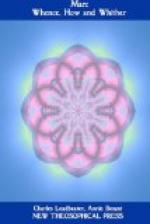In the highest mammals we find also different degrees of attention and concentration of thought and observation. This difference can easily be noticed in young hunting dogs. A trainer of monkeys said that he could easily select those which could most easily be taught, by noticing in the first lesson whether he could easily gain and hold their attention. This was easy with some, while others were diverted by every passing fly; and the latter, like heedless students, made but slow progress.
It is interesting to notice that one of the perceptions which we class among the highest is apparently developed comparatively early. I refer to the aesthetic perception of the beautiful. Now, the perception of beauty is generally considered as not very far below or removed from the perception of truth and right. But some insects and birds apparently possess this perception and the corresponding emotion in no low degree. The colors of flowers seem to exist mainly for the attraction of insects to insure cross-fertilization, and certain insects seem to prefer certain colors. But you may say that these afford merely sense gratification like that which green affords to our eyes or sugar to our tastes.
But does not the grouping of colors in the flower appeal to some aesthetic standard in the mind of the insect? What of the tail of the peacock? Its iridescent rings and eyes evidently appeal to something in the mind of the female. Do form and grouping minister to pure sense gratification? What of the song of the thrush? Does not the orderly and harmonious arrangement of notes and cadences appeal to some standard of order of arrangement, and hence idea of harmony, in the mind of the bird’s mate?
Now, I grant you readily that the A B C of this training is mere sense gratification at the sight of bright colors. Most insects and birds have probably not advanced much beyond this first lesson. Savages have generally stopped there or reverted to it. But any appreciation of form and harmonious arrangement of cadence and colors seems to me at least to demand some perception which we must call aesthetic, or dangerously near it. But here you must judge carefully for yourselves lest you be misled. For remember, please, that those schemes of psychology farthest removed from, and least readily reconcilable to, the theory of evolution maintain that perception of beauty is the work of the rational faculty, which also perceives truth and right in much the same way that it perceives and recognizes beauty. If the animal has the aesthetic perception, it has the faculty which, at the next higher stage of development, will perceive, and recognize as such, both truth and right. We are considering no unimportant question; for on our answer to this depends our answer to questions of far greater importance.




